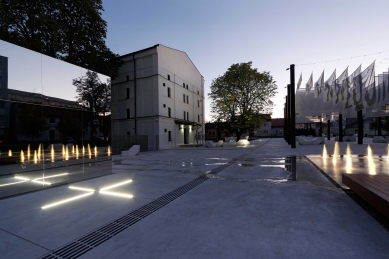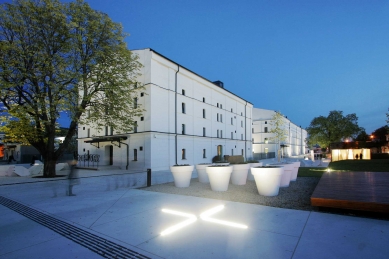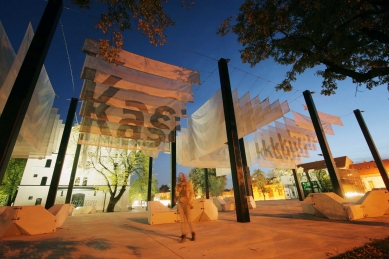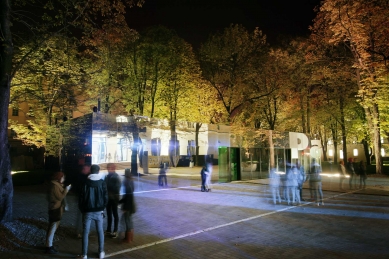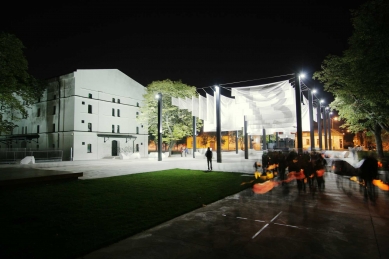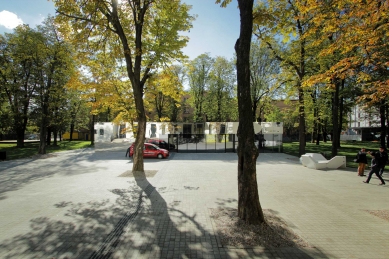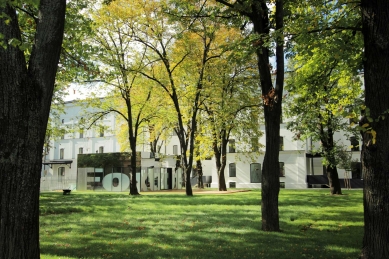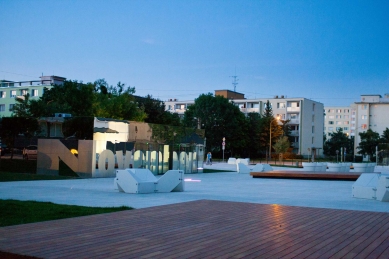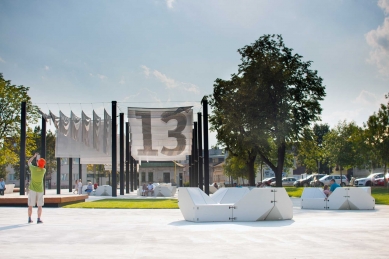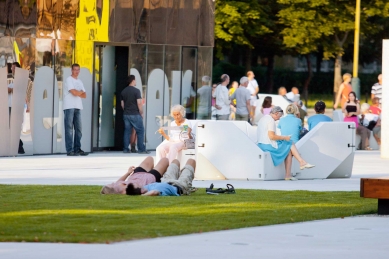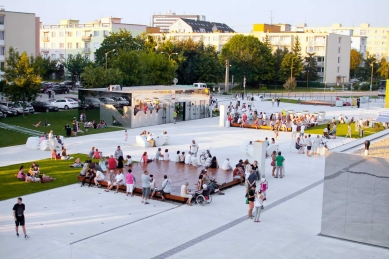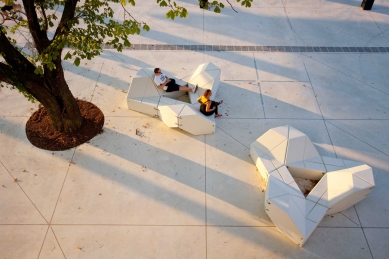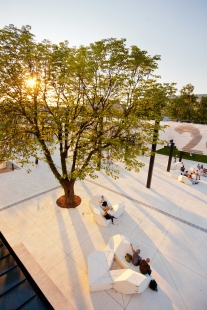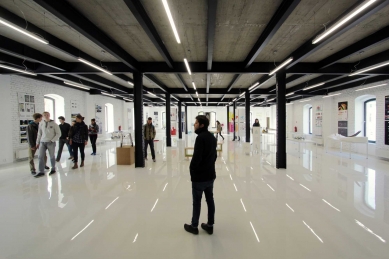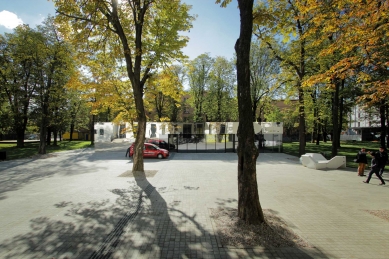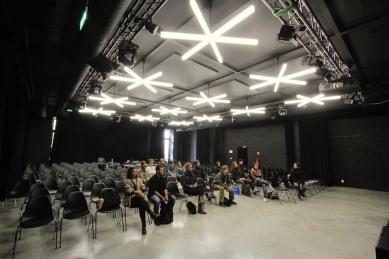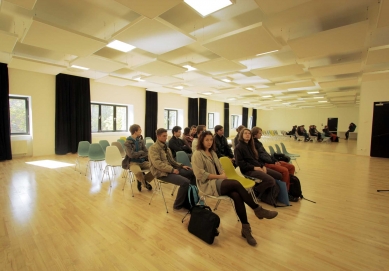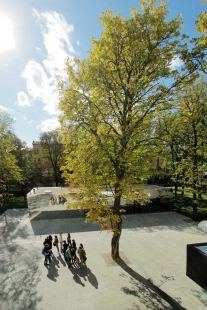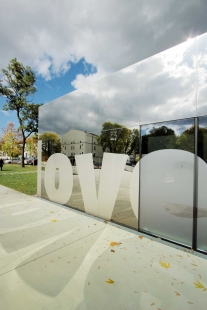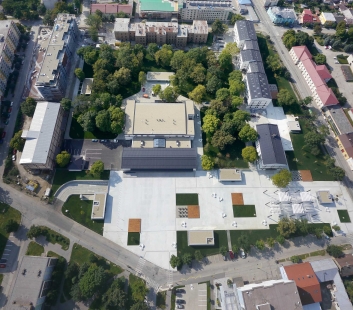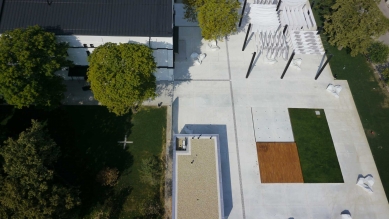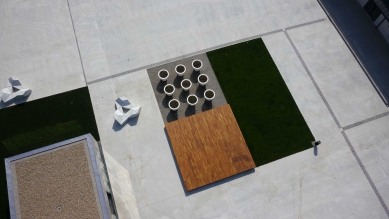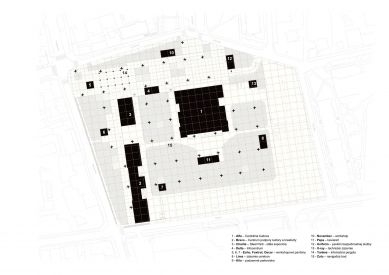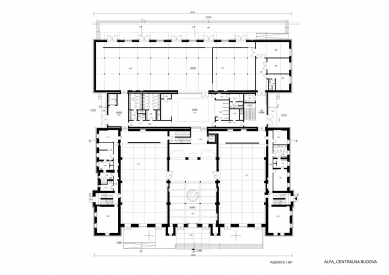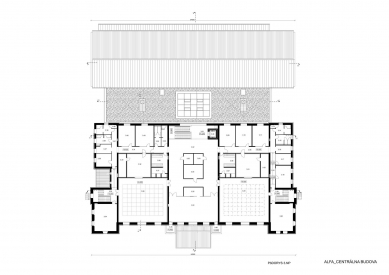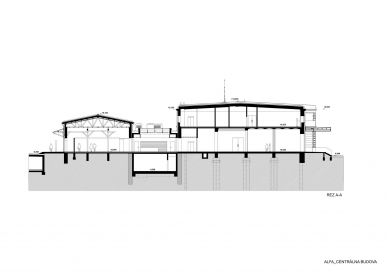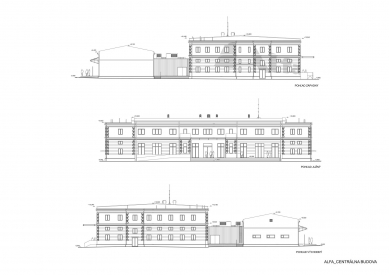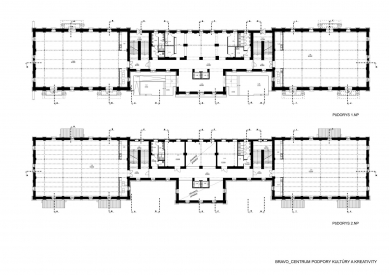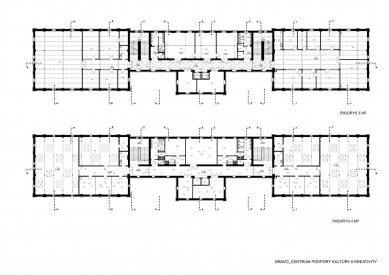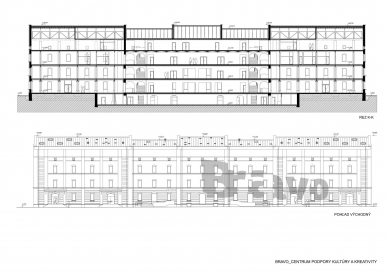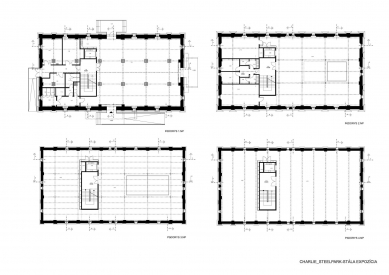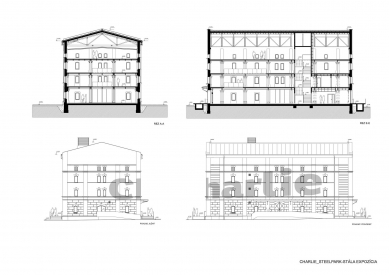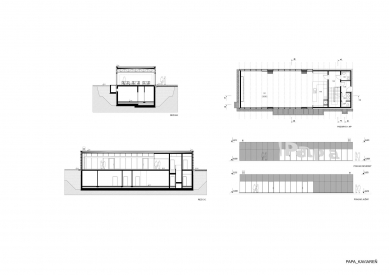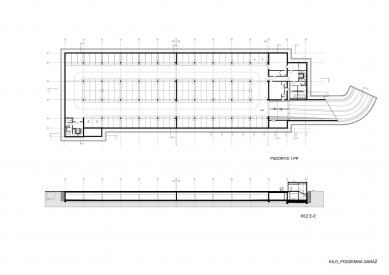
Kulturpark

The military complex of the supply barracks was built by the Austro-Hungarian army in the two closing decades of the 19th century. The introvert complex surrounded by a wall included three provisions and materiel storage buildings, a bakery and the headquarters building as well as a stand-alone water house. Along with this complex, a park has been established. The confined complex, inaccessible to the public, was utilised during the communist regime by the Czechoslovak People’s Army. In 2008, the city of Kosice was awarded the title of the European Capital of Culture for the year 2013.
A two-round architectural and urban design competition to transform this complex into a multi-purpose cultural centre has been announced in 2009 and – after winning it – zerozero signed a contract and developed all phases of the project. The winning design identified a unique potential of the wonderful historic park, with hundred-years-old chestnut trees which occupied the central part of the block. We have proposed to remove the wall separating it from the neighbouring fabric of the city. This way we have opened the whole area to the city, its inhabitants and visitors.
We have designed a public space surrounding the whole perimeter of the block, complementing the original park. This was at the time when Kosice lost its Namestieosloboditelov square to a shopping centre under construction.
Thus we have offered the city a new public space, a place of social interaction, a meeting and exchange hotspot, as well as a communication channel between the Kulturpark complex and the city. We have proposed to turn an introvert, enclosed complex into an open public space with a park. Both of these complementary environments create a framework for the creation and presentation of the arts.
The objective was to revitalize the complex as follows: to restore the three historic buildings for new cultural and educational purposes, build a new series of smaller pavilion buildings, construct a new underground parking, revitalize the park, create a new public space as well as associated traffic and services infrastructure. From the perspective of this competition, the most significant is the renovated park, the new square, small architectural elements, the illumination, the fountain and the site furnishings.
Our main goal was to open the complex up toward the city, create a new public space with a park. The overall design was influenced by the analysis of the original historic buildings and their arrangement. The buildings were laid out in a strict geometrical pattern, with a 5 x 5m grid. We have developed a new grid of 8 x 8m, spread throughout the extents of the site, respecting the location of the original buildings. The layout of this new grid determines both the positioning and the dimensions of the new pavilions, structuring of the urban space into respective blocks, distribution and sizes of green lawn areas, fountains, wooden platforms around the square and in the park.
The new pavilions form a network, and they were intended to expand the activities and programs in the historic buildings out into the square and the park, to ensure that every part of the complex is alive. As a reminder of the original military character of the complex, each structure and platform displays a name on their physical structure, representing the international phonetic alphabet: alfa, bravo, charlie, delta, echo, foxtrot, papa, lima, romeo, juliet, etc. Besides its poetic aspect, the application of the text gave the structures their own identity and provides a positional information.
European Cities of Culture usually tend to promote themselves by means of a new iconic architecture. By contrast, Kosice unorthodoxly offered a new square and a park. With its approximately 8,000 sq.m, the new urban space of the square is the main gathering point of the Kulturpark. It can also be used for a variety of exterior concerts, events, exhibitions and activities. The primary purpose of the park with a total area of approximately 15,000 sq.m is leisure, but it can also be used for smaller events and art exhibitions. The original number of 177 trees has been increased by 33 newly-planted ones and a new lawn, paved areas within the complex and a small piazetta square in front of the main building entrance.
The design of the public space - the square - is fully derived from the basic geometrical grid and the shape of the property, defined by the road network encircling the block. The 8 x 8m grid delineates the basic geometrical break-up of the area into separate blocks, resulting in pixels with various function and material expression. From the east to the west, the structure is getting denser towards the corner of Rastislavova Street, which is an important thoroughfare in this part of Kosice. The whole urban space has been rendered in white concrete, thus achieving a strong identity as well as a clear demarcation line of our on-site intervention. The area is rasterised by the lines cut in the basic grid to smaller squares of 4 x 4m and filled with joint filler. This basic framework is complemented by diagonal cut lines aligned with the squares. The diagonal lines have a guiding role as well since they are connected to the main traffic routes on the property.
Inserted in the white concrete grid are pixels of leisure lawns, acacia wood platforms to hold small events, gravel squares with fragrant herb planters and so on. Wooden platforms were placed in both the environments: the square and the park. Located at the prominent north-western edge of the square is a visual-communication cluster, having an urban pergola character - shading the square on one hand and serving as a robust information hub on the other. Canvases with cloth-printing inform about the events in the Kulturpark. The illumination of the square and the park is also laid out on the established grid. Morphing within the basic grid delivers an overlying system of approximately 24 x 24m across the square as well as the park and 46 programmable cross-shaped LED light fixtures were arranged within this framework. Four boreholes deliver sufficient ground water to irrigate the lawns and feed the fountain. Approximately 45% of the rainwater from the paved areas is being drained by natural infiltration into the ground.
A separate layer contributing to the square and park environment is the site furnishings designed for this occasion by the PPAG of Vienna. This modular system consisting of 100 white hard plastic elements allows for a variety of configurations and user modes.
Kulturpark is generally rated as the most successful investment project of the ECC 2013. Following the completion in August 2013, the square and the park were the centre of the „Summer in the Park“ festival. A great number of concerts, exhibitions, events and workshops took place there as part of this festival, attended by thousands of visitors. The new urban space has become popular among the skaters, bikers and urban extreme sports enthusiasts. Organizing big concerts, however, requires a careful time management to avoid noise disturbance to the residents in the neighbourhood. Therefore late night concerts are being held indoors in the central Alfa building in the middle of the complex.
A two-round architectural and urban design competition to transform this complex into a multi-purpose cultural centre has been announced in 2009 and – after winning it – zerozero signed a contract and developed all phases of the project. The winning design identified a unique potential of the wonderful historic park, with hundred-years-old chestnut trees which occupied the central part of the block. We have proposed to remove the wall separating it from the neighbouring fabric of the city. This way we have opened the whole area to the city, its inhabitants and visitors.
We have designed a public space surrounding the whole perimeter of the block, complementing the original park. This was at the time when Kosice lost its Namestieosloboditelov square to a shopping centre under construction.
Thus we have offered the city a new public space, a place of social interaction, a meeting and exchange hotspot, as well as a communication channel between the Kulturpark complex and the city. We have proposed to turn an introvert, enclosed complex into an open public space with a park. Both of these complementary environments create a framework for the creation and presentation of the arts.
The objective was to revitalize the complex as follows: to restore the three historic buildings for new cultural and educational purposes, build a new series of smaller pavilion buildings, construct a new underground parking, revitalize the park, create a new public space as well as associated traffic and services infrastructure. From the perspective of this competition, the most significant is the renovated park, the new square, small architectural elements, the illumination, the fountain and the site furnishings.
Our main goal was to open the complex up toward the city, create a new public space with a park. The overall design was influenced by the analysis of the original historic buildings and their arrangement. The buildings were laid out in a strict geometrical pattern, with a 5 x 5m grid. We have developed a new grid of 8 x 8m, spread throughout the extents of the site, respecting the location of the original buildings. The layout of this new grid determines both the positioning and the dimensions of the new pavilions, structuring of the urban space into respective blocks, distribution and sizes of green lawn areas, fountains, wooden platforms around the square and in the park.
The new pavilions form a network, and they were intended to expand the activities and programs in the historic buildings out into the square and the park, to ensure that every part of the complex is alive. As a reminder of the original military character of the complex, each structure and platform displays a name on their physical structure, representing the international phonetic alphabet: alfa, bravo, charlie, delta, echo, foxtrot, papa, lima, romeo, juliet, etc. Besides its poetic aspect, the application of the text gave the structures their own identity and provides a positional information.
European Cities of Culture usually tend to promote themselves by means of a new iconic architecture. By contrast, Kosice unorthodoxly offered a new square and a park. With its approximately 8,000 sq.m, the new urban space of the square is the main gathering point of the Kulturpark. It can also be used for a variety of exterior concerts, events, exhibitions and activities. The primary purpose of the park with a total area of approximately 15,000 sq.m is leisure, but it can also be used for smaller events and art exhibitions. The original number of 177 trees has been increased by 33 newly-planted ones and a new lawn, paved areas within the complex and a small piazetta square in front of the main building entrance.
The design of the public space - the square - is fully derived from the basic geometrical grid and the shape of the property, defined by the road network encircling the block. The 8 x 8m grid delineates the basic geometrical break-up of the area into separate blocks, resulting in pixels with various function and material expression. From the east to the west, the structure is getting denser towards the corner of Rastislavova Street, which is an important thoroughfare in this part of Kosice. The whole urban space has been rendered in white concrete, thus achieving a strong identity as well as a clear demarcation line of our on-site intervention. The area is rasterised by the lines cut in the basic grid to smaller squares of 4 x 4m and filled with joint filler. This basic framework is complemented by diagonal cut lines aligned with the squares. The diagonal lines have a guiding role as well since they are connected to the main traffic routes on the property.
Inserted in the white concrete grid are pixels of leisure lawns, acacia wood platforms to hold small events, gravel squares with fragrant herb planters and so on. Wooden platforms were placed in both the environments: the square and the park. Located at the prominent north-western edge of the square is a visual-communication cluster, having an urban pergola character - shading the square on one hand and serving as a robust information hub on the other. Canvases with cloth-printing inform about the events in the Kulturpark. The illumination of the square and the park is also laid out on the established grid. Morphing within the basic grid delivers an overlying system of approximately 24 x 24m across the square as well as the park and 46 programmable cross-shaped LED light fixtures were arranged within this framework. Four boreholes deliver sufficient ground water to irrigate the lawns and feed the fountain. Approximately 45% of the rainwater from the paved areas is being drained by natural infiltration into the ground.
A separate layer contributing to the square and park environment is the site furnishings designed for this occasion by the PPAG of Vienna. This modular system consisting of 100 white hard plastic elements allows for a variety of configurations and user modes.
Kulturpark is generally rated as the most successful investment project of the ECC 2013. Following the completion in August 2013, the square and the park were the centre of the „Summer in the Park“ festival. A great number of concerts, exhibitions, events and workshops took place there as part of this festival, attended by thousands of visitors. The new urban space has become popular among the skaters, bikers and urban extreme sports enthusiasts. Organizing big concerts, however, requires a careful time management to avoid noise disturbance to the residents in the neighbourhood. Therefore late night concerts are being held indoors in the central Alfa building in the middle of the complex.
zerozero
0 comments
add comment



